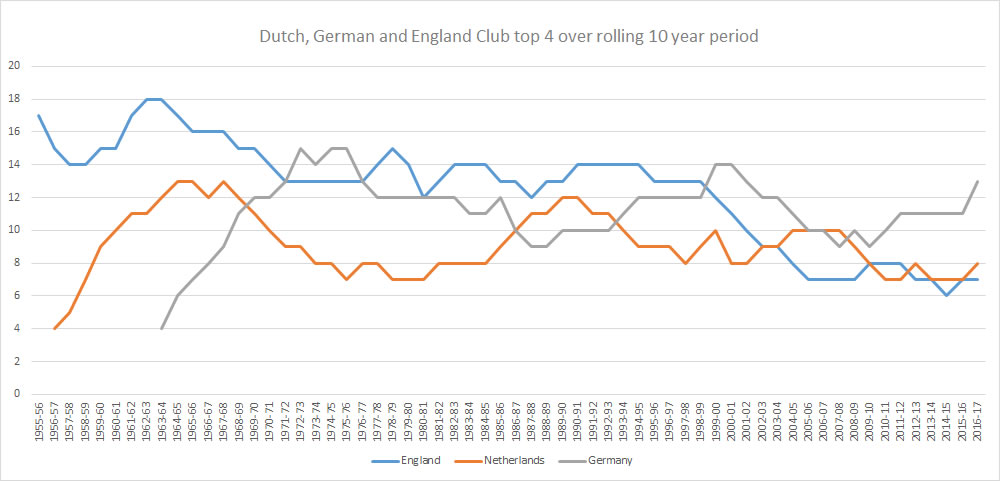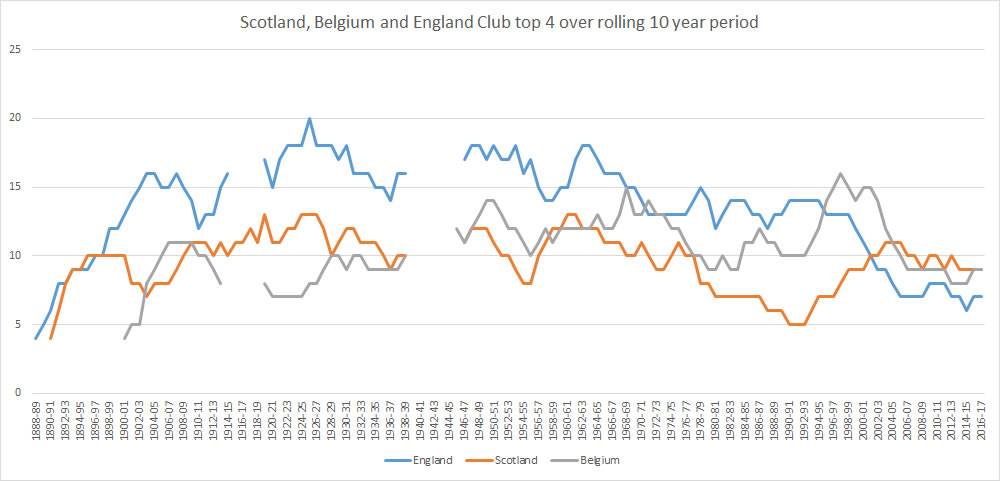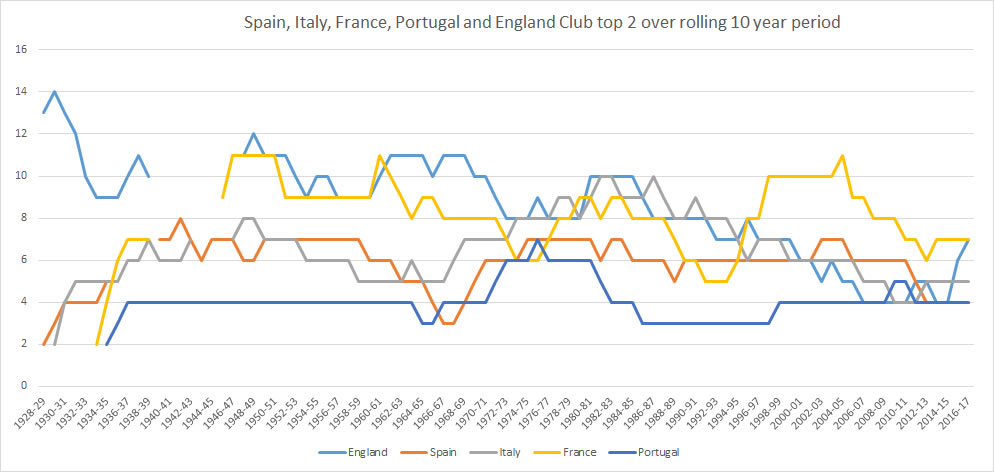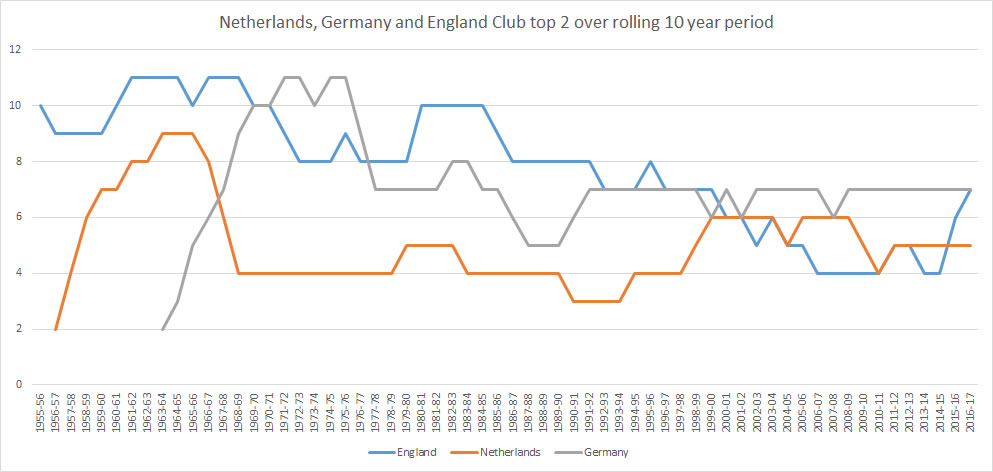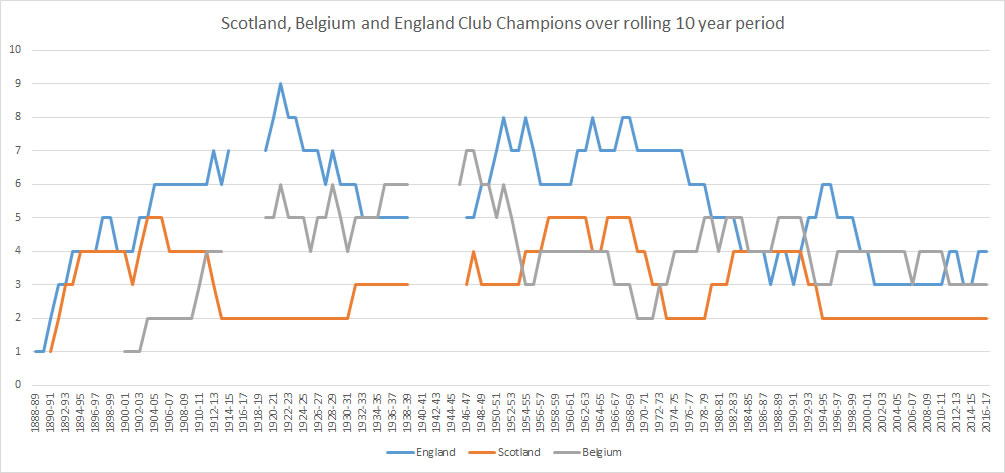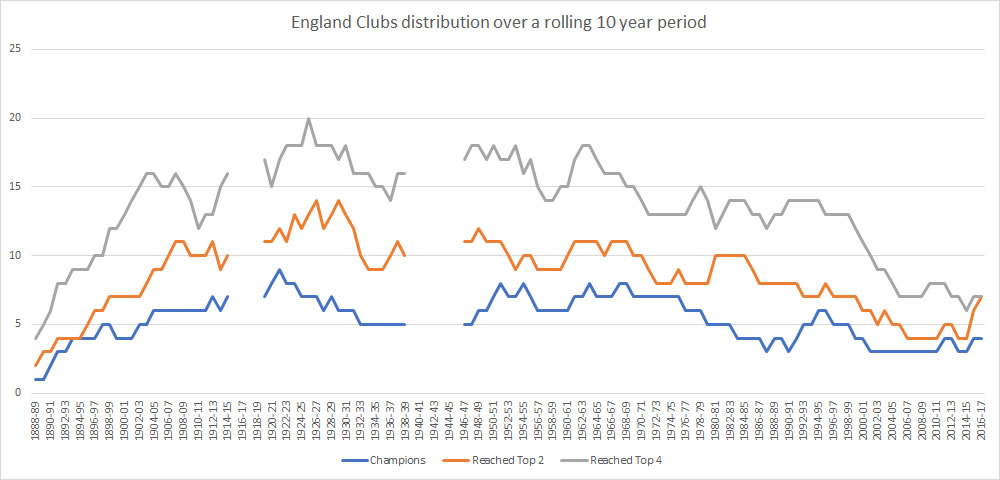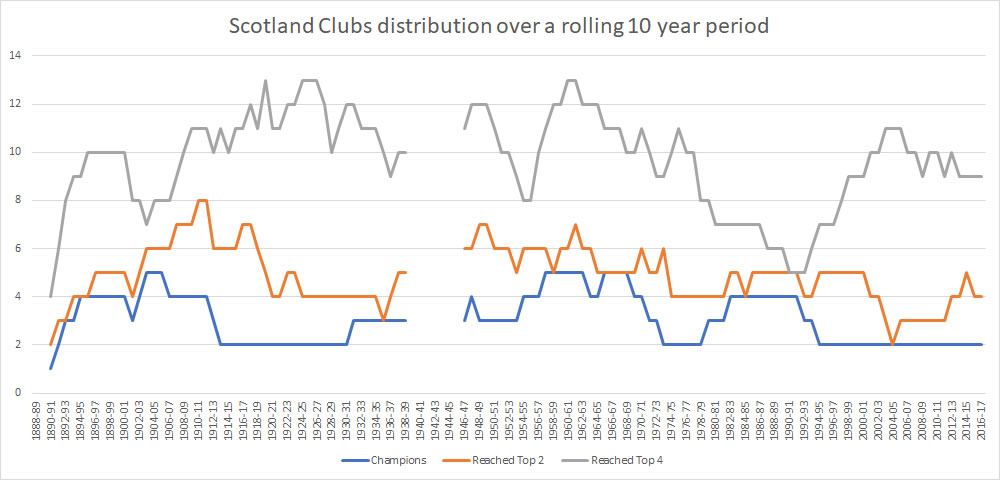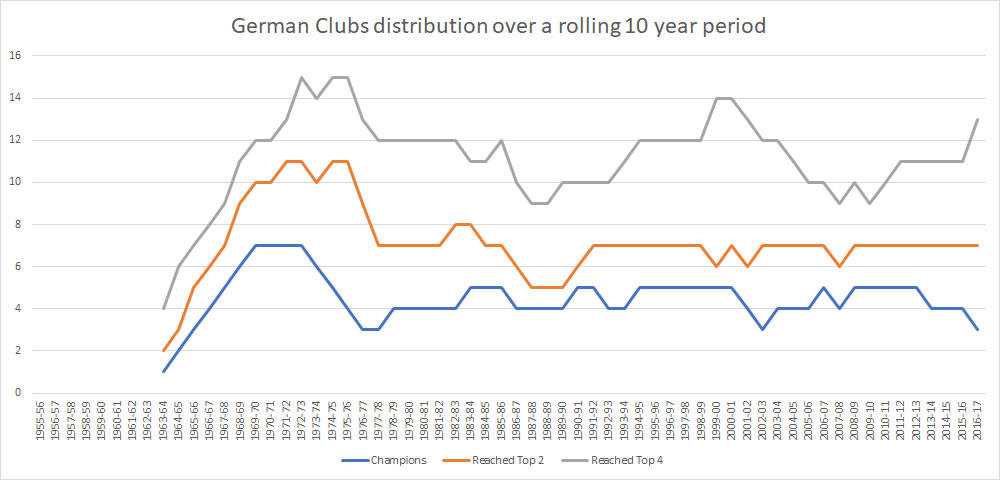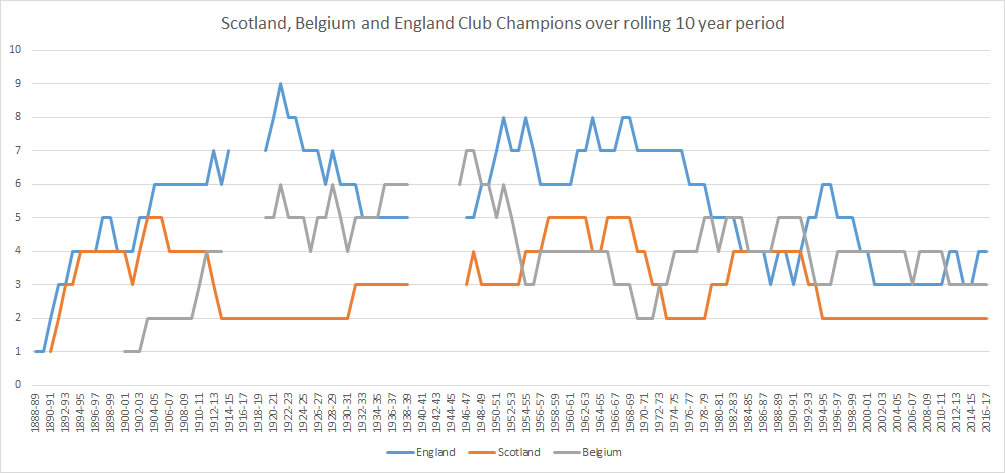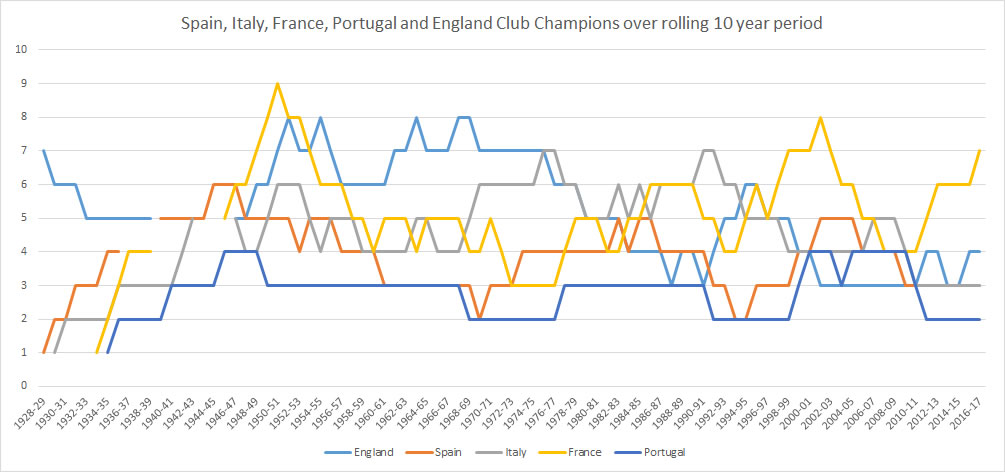By David Coalman 17th February 2018
Back in the day it was said that in the old First Division any club could defeat any other club and this was one of the glories of our league. It was uniquely and consistently competitive and exciting to watch. The First Division, it was claimed, was more competitive than any of the major leagues in Europe. This on the face of it was a bold and arrogant claim, but not a claim you hear said about the current Premier League. The Premier League feels less competitive, or rather, it does to people who remember the old First Division in the 1960’s, 1970’s and 1980’s.
Let’s take a close look at four questions to assess this.
Was the old First Division uniquely competitive?
Was it more competitive than any league in Europe?
Is the Premier League as competitive now?
How has the Champions League changed league football here and in Europe?
Feelings are one thing, but do the facts back this feeling up? So how can we measure competitiveness? The first way in this article we will consider is to look at who finishes in the top 4 each season and then calculate how many clubs finish in the top 4 over a rolling 10 season period.
At the end of the 2014-15 season, the top four of the Premier League were Chelsea, Manchester City, Arsenal and Manchester United. If you factor in the previous 9 seasons, Arsenal had placings in the top 4 in every season. Manchester United and Chelsea had top 4 placings in 9 out of the last 10 whilst Manchester City managed it 5 times. There were only 2 other clubs who had finished in the top 4 over this period, Liverpool who managed it 5 times and Tottenham Hotspur who managed it twice. Perhaps unsurprisingly these two clubs finished 5th and 6th in 2014-15.
It looked like domination by these 6 ‘super’ clubs was confirmed forever, and then Leicester City happened. Leicester City breaking into the top 4 was remarkable enough, the first time since 1962-63, but winning the Premier League was an outstanding achievement. So did this lead to a breaking of the super 6 strangle hold? Well no not at all, the top 6 over the 10 year period remained constant. Normal service is maintained.
If we go back 100 years to the 1914-15 season a First Division of 20 clubs, like the Premier League today, the previous 10 seasons had seen 16 clubs finish in the top 4. This wasn’t the peak number though. In 1925-26 a First Division of 22 clubs, 20 clubs had finished in the top 4 in the previous 10 seasons. This competitiveness fell in the early to mid-1930s with the domination of Arsenal. The number of clubs finishing in the top 4 fell to 14 clubs in 1936-37, before recovering to 17 clubs in the last ten seasons before the start of the Second World War.
Post WW2 the First Division was still a relatively wide open competition. This continued much the same through the years of Liverpool’s domination in the 1980s and Manchester United’s domination of the 1990s. In 1998-99, and the 10 seasons before, 13 clubs had finished in the top 4, this was the turning point though. Between 1998-99 and 2006-07 the Premier League saw a massive crash in competitiveness. The 10 seasons to 2006-07 saw only 7 clubs managing to gain a top 4 spot. Apart from the occasional visit of Everton, Leeds United and Leicester City, the afore mentioned big 6 clubs have monopolised the top 4 positions since.
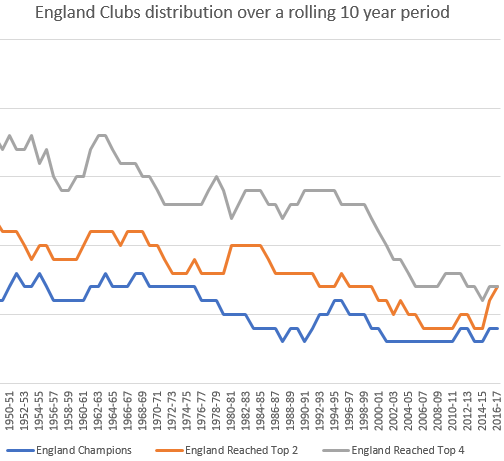
This in some regard answers two of the three questions put earlier. In many ways the old First Division was uniquely competitive and competitive over its entire history, continuing through the early years of the Premier League.
In 1992 the First Division became the Premier League, at the same time the European Cup became the Champions League. The format of the Champions league was very different from how it is today. In 1997 the Champions League morphed into a competition that included runners up and also rans. It is now neither a cup competition for champions, nor a league. Ironically it was Manchester United winning the Champions League in 1999 that shone a light on what it had become. For they were the first champions of Europe who had not been national champions the previous season or current champions of Europe.
As it expanded to accommodate more and more “also rans” the Champions League devalued the accolade of winning the Premier League. Due to its current coefficient ranking, the Premier League has been able to command 4 places in the Champions League. It seems making money is the real aim of football and not the glory of winning the league or the cup. The most important task is now getting into the top 4.
The last English club to win the European Cup/Champions League was Chelsea back in 2012. To get to the final Chelsea had to play 12 games. Manchester United back in 1967 had to only play 8 games to get to the final. This might look like Chelsea or indeed any Champions League winners today have more hurdles to jump than in the past, but because of the group stage, it is now possible to finish second in a group and still get to the final. Those extra games generate considerable gate and TV revenue. In the group system, teams can now suffer 2 or even 3 bad games and still stay in the competition, where as in the old European Cup format one bad result would be unrecoverable even with a second leg to play.
It looks like the current format of the Champions League has drained the competitiveness out of the Premier League, but what has it done to the other European leagues and how do they match up against the league here?
Of the European leagues only the Scottish and Belgian leagues compare in longevity. Up until the First World War the English league was substantially more competitive than both when considering top 4 finishes. Between the wars, this was still the case and this continued up until the crash in competitiveness in the Premier League between 1999 and 2007, the old established leagues in Belgium and Scotland now look more, not less competitive.
In the 1930’s Spain, France, Italy and Portugal established football leagues. After various civil and international wars these leagues settled down into a less competitive form than the First Division, with the occasional exception of the French league. The other three were consistently less competitive and stayed so until the end of the 20th Century. Again by 2007 the Premier League was at the bottom compared to these leagues.
Dutch and German league football only really got their act together in the late 1950’s and early 1960’s. Apart from early on in its inception, they trailed behind the First Division. Today this has reversed.
Interestingly, the current Champions League format has also drained the competitiveness out of the other European leagues we have looked at. The Belgian league has suffered the same fall since 1999. The Scottish league has stayed the same over all, whilst the Premier League has fallen below both, notwithstanding the tax problems effecting one of the big two clubs north of the border.
Of the remaining Countries Spain, Portugal and Italy have suffered this same draining effect from the current Champions League format, but not to the same extent as the Premier League. France is the only exception, like Scotland, they seem to be unaffected. The Dutch and the German leagues have also experienced divergent effects since 1999. The Dutch league has become less competitive, whilst the German league has seen a marked increase in the number of clubs getting into the top 4 over a ten year period. The emergence of clubs like Hoffenheim, Wolfburg and Leipzig RB have made the German league look as competitive as the old First Division used to be, but is this really the case?
Let’s take a look at clubs who are champions or runners up of their league over a decade. This paints a very different picture. At present the Premier League had 7 clubs in the top 2. Both Belgium and Scotland have had fewer clubs over the same period. The 1999 to 2007 crash was still there in the Premier League numbers, but more uneven in its effects.
As for winning the league England and Belgium are similar with 4 different champions over the last 10 seasons, whereas Scotland has had the same 2 clubs winning the league for decades. The dominance of first Liverpool and then Manchester United did affect the number of champions over a given decade, but not to the extent as in Scotland.
Many of the glamourous European leagues are dominated by 2, 3 or 4 big clubs, even in larger countries like Spain and Italy. Looking at top 2 finishes, the Premier League looks much better. All leagues saw a nose dive after 1999. The Premier League has experienced an uptick in competitiveness directly related to the end of Manchester United’s dominance. At present it has more clubs in the top 2 over the last decade than Spain, Italy or Portugal. France is the only exception. This is also reflected in the number of clubs that finish as champions in these countries.
With the Dutch and the Germans you get a similar story. The Premier League matches the German league in numbers in the top 2 and both have left the Dutch far behind. The numbers finishing as champions is a different story. The triumvirate of Ajax, PSV Eindhoven and Feyenoord plus wins for less well known clubs keeps the Dutch league more competitive. The German league is dominated by Bayern Munich, winning 7 of the last 10 championships, to an extent that is not seen in other European leagues. This is the German league’s weakness at present, no club, not even Borussia Dortmund has found the answer to this problem.
So the €1.3bn elephant in the room is the Champions League. The Champions League has drained competitiveness out of all the major leagues in Europe. Apart from the occasional visit from the likes of Leicester City, the Premier League is much less competitive than the old First Division. If 2 of the super 6 miss out on a Champions League place, they inevitably qualify for the Europa League.
To summarise our findings from the 4 questions we asked
Was the old First Division uniquely competitive? Yes
Was it more competitive than any league in Europe? Yes
Is the Premier League as competitive now? No
How has the Champions League changed league football here and in Europe? It has drained the competitiveness out of all of the leagues.
The old adage that on its day any club could beat any other club in the First Division may have gone, it has been replaced by a new one. When it comes to winning the Premier League it is still more competitive than the other leading leagues in Europe. Having 6 clubs all with enough resources to win the league has made the Premier League the most dynamic in Europe and the most popular around the world. Perhaps in time the sleeping giants such as Aston Villa, Everton, Leeds United, Newcastle United, Sunderland and also West Ham United, with their new stadium, will be able to break the super 6 monopoly. If Leicester City can do it why not?
David Coalman
February 2018

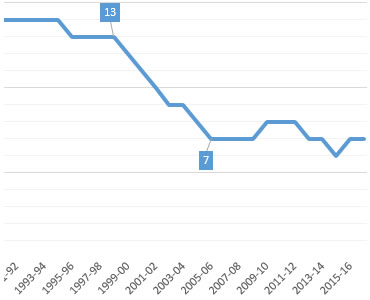
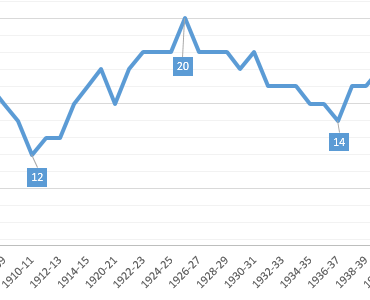
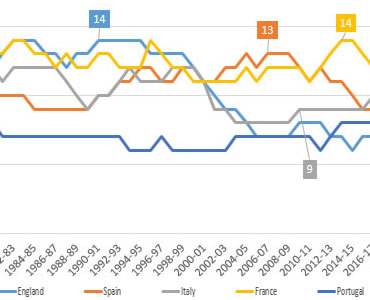
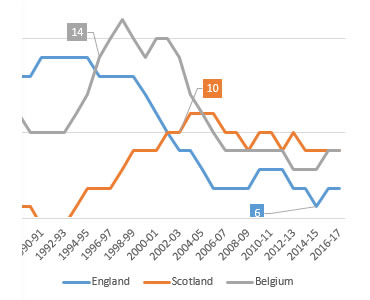 Snapshot of competativeness in the 1990s and 00s between the England, Scotland and Belgium leagues relating to the top 4 clubs.
Snapshot of competativeness in the 1990s and 00s between the England, Scotland and Belgium leagues relating to the top 4 clubs.


